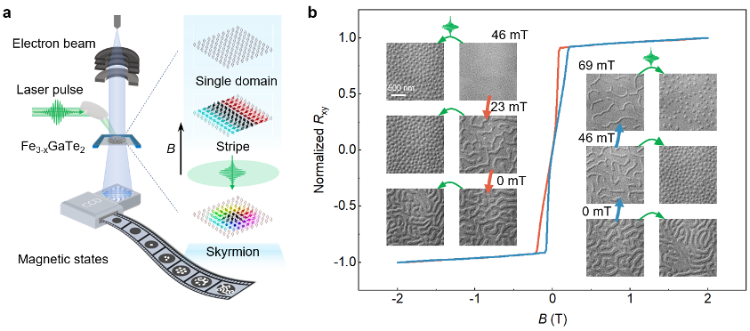NKU Team Makes Important Progress in the Field of Two-dimensional Topological Magnetic Materials and Their Ultrafast Regulation
Recently, Professor Fu Xuewen’s team from the Ultrafast Electron Microscopy Laboratory of the School of Physics of Nankai University, in collaboration with the team of Professor Hou Zhipeng from South China Normal University, the team of Professor Yimei Zhu from the Brookhaven National Laboratory in the United States and others, reported on the room-temperature high-density Néel-type magnetic skyrmions in room-temperature two-dimensional magnetic material Fe3-xGaTe2, and demonstrated novel physical phenomena such as the topological Hall effect of magnetoelectric transport in the sample and the writing of topological spin textures by a single femtosecond laser, providing new materials and mechanisms for the development of low-power and high-density two-dimensional topological magnetoelectric functional devices. The study was published in the key international academic journal Nature Communications on February 3, entitled “Room-temperature sub-100nm Néel-type skyrmions in non-stoichiometric van der Waals ferromagnet Fe3-xGaTe2 with ultrafast laser writability”.
Magnetic skyrmions are vortex-like spin arrangement with topological protection, distinguished by small size and high stability of quasiparticle properties, as well as the tunable capacity with sensitive response to magnetic, electrical, optical, thermal and other physical fields. It is regarded as an ideal new-generation logical information carrier, and has broad application prospects in the fields of racetrack memory, magnetic tunnel junction, spin nano-oscillator, and brain-inspired computing. In the theoretical image, the Dzyaloshinskii-Moriya interaction (DMI) causes the neighbor spins to be non-collinear in configuration and is an important physical mechanism for the formation of magnetic skyrmions. To obtain DM interaction, it is necessary to satisfy the need for crystal structure of specific symmetry-breaking. The traditional magnetic skyrmion material systems primarily focus on the chiral magnets MnSi and Cu2OSeO3 with natural symmetry-breaking and the magnetic metal heterogeneous multilayer film Ta/CoFeB/TaOx with mirror-inverted symmetry-breaking and other three-dimensional material systems. Despite the fact that van der Waals magnetic two-dimensional material system attracts great attention in the field of magnetism and spintronics for its unique properties, the crystal structure with space-inversion symmetry in most magnetic two-dimensional materials reduces the possibility of realizing intrinsic DM interactions, limiting their applications in topological magnetics and other areas. Therefore, the question of how to introduce DM interaction into magnetic two-dimensional materials, realize small-sized Néel-type magnetic skyrmions, and explore the potential for room temperature regulation and application is a hot topic in the fields of materials science, condensed matter physics, and even information technology in today’s world.

Figure 1 (a) Schematic diagram of the crystal structure of stoichiometric Fe3GaTe2 and non-stoichiometric Fe3-xGaTe2 sample. (b) Spherical aberration electron microscopy atomic-scale image of a non-stoichiometric Fe3-xGaTe2 sample. (c) Strong DM interaction caused by structural symmetry breaking in the non-stoichiometric Fe3-xGaTe2 sample. (d) Néel-type magnetic skyrmions observed on Lorentz electron microscopy.
Based on the room-temperature ferromagnetic two-dimensional material Fe3GaTe2 (P63/mmc space group, space-inversion symmetry), the research team introduced the mirror-inversion symmetry-breaking caused by Feii atom shift through the asymmetric vacancy control of Fei atom (Figure 1a). The structural analysis showed (Figure 1b) that the space group of the non-stoichiometric Fe3-xGaTe2 sample was P3m1, which had the structural conditions to realize strong in-plane DMI (Figure 1c). Measurements of magnetoelectric transport showed that there was a significant topological Hall effect in the sample, and this may be related to the non-collinear spin textures. Further field cooling experiments of Lorentz electron microscopy showed that there are indeed small-size and high-density Néel-type magnetic skyrmions in this sample, which can be stably present at a temperature of up to approximately 330 K while it can be as thin as about 40 nm. Its superior room-temperature performance provides an ideal material platform for the development of two-dimensional topological magnetoelectric functional devices.

Figure 2 (a) Schematic diagram of an in-situ laser-pumped Lorentz electron microscopy. (b) In-situ single-shot femtosecond pulse laser realizes the magnetic skyrmion writing process.
In order to further demonstrate the possibility of ultrafast regulation and application of this sample at room temperature, the research team studied the ultrafast regulation process (Figure 2a) of femtosecond laser pulses on the transformation of topological spin textures in situ based on the independently designed 4D ultrafast Lorentz transmission electron microscopy (Figure 2a). It realized the in-situ visual measurement of magnetic structures such as striped domains, single magnetic domains, and magnetic skyrmions with controlled writing of femtosecond laser pulses, and revealed the internal physical mechanism of femtosecond laser-induced topological magnetic transformation by combining micromagnetic dynamics simulation. Different from the traditional magnetic skyrmion writing method such as quasi-static continuous field cooling and current Joule heating effect, femtosecond laser pulse offers advantages such as low energy consumption, local focusing, and fast speed, providing a new way to realize the efficient writing of topological magnetic domains. It is of great significance for the design and development of new topological magnetic skyrmion information storage devices.
Nankai University is the first author unit and the corresponding unit of this study. Li Zefang, a postdoctoral fellow at Nankai University; Zhang Huai, a doctoral student at South China Normal University; and Li Guanqi, a lecturer at Guangdong University of Technology, are the co-first authors of the paper. Professor Hou Zhipeng of South China Normal University, Professor Yimei Zhu of Brookhaven National Laboratory in the United States, and Professor Fu Xuewen of Nankai University are the co-corresponding authors.
Link:https://www.nature.com/articles/s41467-024-45310-2
(Edited and translated by Nankai News Team.)









